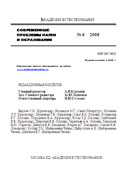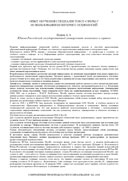PDF-версия статьи


|
Fiber Optic Sensors have lately found more applications due to their high precision, large dynamic range, electrical insulation, miniature, immunity to electromagnetic interference, high-speed operation, the possibility to transmit information over long distances [1, 2]. Gradually, fiber-optic sensors are replacing sensors with mechanical and electrical conversion of the measured parameter to the information signal. They are used for measuring the current magnetic field, displacement, temperature, pressure, acoustic vibration, etc.
Fiber-optic current sensors designing are designed based on the Faraday’s effect. Faraday’s effect is a magneto-optical effect, when a linearly polarized light going through an optically inactive substance in a magnetic field, produces a rotation of the plane of the polarized light.
The Faraday’s effect is used in a fiber-optic current sensors [3], because there is a large number of glass optical fibers in which it is sufficiently pronounced [4]. These optical elements have a large Verde constant V (physical quantity that characterizes the magnetic rotation of the plane of polarization in the material), which connects the value of the integral of the magnetic field Н, taken across the length of the optical path L, and the angle of the plane of linearly polarized light ΔФ, transmitted through the optical circuit:
This angle ΔФ is also equivalent to nonreciprocal phase shift of a circularly polarized wave transmitted through a fiber loop. For the right circular wave ΔФ is positive, for the left circular wave it is negative. The simplest FOCS using the Faraday’s effect is a polarimetric sensor. It the current in a conductor is associated with rotation of the plane of polarization of light passing a closed loop through which current-carrying conductor is passed.
This equation is true for single-mode optical fiber with the approximation that the Verde constants for core and cladding differ slightly, otherwise the angle ΔФ depends on these constants and refractive indices of the core and cladding [5].
For signal ΔФ irrespective Int0 intensity is not stable in time, the output signal S is calculated as the ratio:
During the measurement the current, created in the installation, had step-in changing available for the power supply range, and layout information from the current meter and ammeter (±0,01% ±7 е.м.р) was recorded on a personal computer at 50 Hz.
For a rough estimation of the error we considered layout, in which current was constant, and it was shown that in the studied range (from -1.2 to +1.2 kA), the absolute accuracy did not exceed 2 A, and the relative accuracy was less than 0.1%.
Thus, the created brassboard allows to demonstrate the meter, built by the author proposed configuration and using created and investigated components. The proposed method minimize the impact of magnetic fields on the measurement.
Reference:
1.A. N. Sokolov, V. O. Yaceev Volokonno – opticheskie datchiki i sistemy : principy postroeniya, Волоконно -оптические датчики и системы: принципы построения, vozmozhnosti i perspektivy // Lightwave. Russian Edition. - 2006. - №4. C. 44 - 46.
2.YU.V. Gulyayev, S.A. Nikitov, V.T. Potapov, YU.K. Chamorovskiy Volokonno-opticheskiye tekhnologii, ustroystva, datchiki i sistemy // Spetsvypusk ≪Foton-ekspress≫. - M.: Nauka, 2005. -№6. C. 114 - 127.
3.E. A. Nekrashevich, N. B. Starostin Volokonno-opticheskiye datchiki toka // Elektronnyye komponenty. – 2006. - №11. C. 76 - 77.
4.I. K Meshkovskiy., V. Ye. Strigalev, S. A. Tarakanov. Zakrytaya skhema obrabotki signala v volokonno-opticheskom datchike toka // Nauchno - tekhnicheskiy vestnik SPbGU ITMO №65. – SPb.: SPbGU ITMO, 2010. C. 10 - 15.
5.M. Takahashi, К. Sasaki, K. Terai Optical current sensor tor DC measurement // Transmission and Distribution Conference and Exhibition 2002: Asia Pacific. IEEE, 2002. vol.1. PP. 440 - 443.
ОПУБЛИКОВАНО
Avdeeva D. K., Turushev N.V., Grigoriev M. G. FIBER OPTIC CURRENT SENSOR. // Современные проблемы науки и образования - 2014.-№6. (приложение "Технические науки"). - C. 14